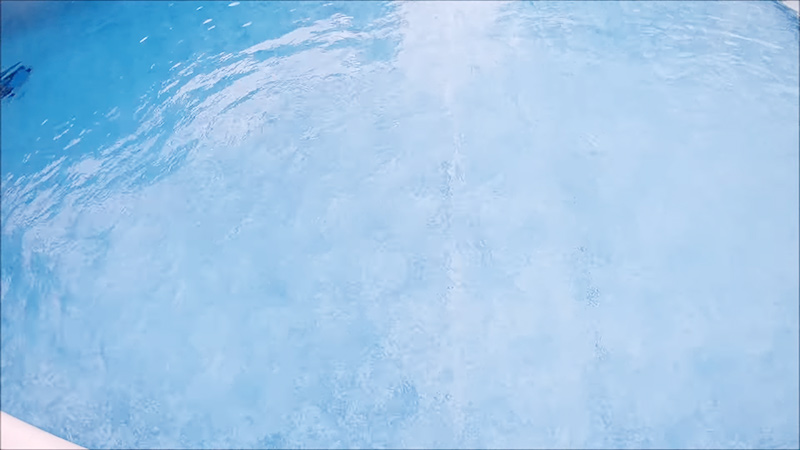Swimming pools are a beloved source of recreation and relaxation, but maintaining their water quality is crucial for a safe and enjoyable experience. Chlorine plays a vital role in disinfecting pool water and keeping it free from harmful bacteria and contaminants.
However, too much of a good thing can turn harmful. In this guide, we’ll explore the critical question: What chlorine level is too high to swim?
Understanding the safe chlorine levels in pool limits of chlorine concentration in your pool is essential to prevent health issues such as skin and eye irritation, respiratory problems, and more serious chemical burns.
We’ll delve into the recommended chlorine levels, the signs of over-chlorination, and steps to rectify the situation. Whether you’re a pool owner or simply enjoy swimming, this information will help you maintain a clean and safe swimming environment.
Let’s dive into the depths of chlorine management and ensure your pool is a source of refreshment, not discomfort.
The Basics of Chlorine in Swimming Pools
Chlorine is the unsung hero of swimming pools, silently working to keep the water safe and crystal clear.
Whether you’re a pool owner or simply enjoy taking a dip, understanding the basics of chlorine is essential for a safe and enjoyable swimming experience.
Sanitization
Chlorine’s primary role in pool maintenance is sanitization. It effectively kills bacteria, viruses, algae, and other microorganisms that can thrive in pool water. This ensures that the water remains safe for swimmers.
Types of Chlorine
There are two main types of chlorine used in pools: liquid chlorine (sodium hypochlorite) and chlorine tablets (trichloroisocyanuric acid or dichloroisocyanuric acid).
Both are effective, but they require different methods of application and have distinct characteristics.
Chlorine Levels
Maintaining the right chlorine level is crucial. The recommended range for chlorine in swimming pools typically falls between 1 to 3 parts per million (ppm).
Too little chlorine can lead to poor water quality, while too much can cause irritation to the skin, eyes, and respiratory system.
pH Balance
Chlorine’s effectiveness depends on the pH level of the water. Ideally, pool water should have a pH level between 7.4 and 7.6. Maintaining proper pH balance ensures that chlorine works optimally.
Testing and Maintenance
Regularly test your pool water using test kits or strips to monitor chlorine levels and pH. Adjustments can be made by adding more chlorine or pH-balancing chemicals as needed.
Safety
While chlorine is essential for pool safety, handling it requires care. Always follow safety instructions when adding chlorine to your pool, and store chemicals in a cool, dry, and well-ventilated area away from children and pets.
Chlorine is the guardian that keeps pool water clean and safe. Understanding its role, maintaining proper levels, and ensuring a balanced pH is fundamental to enjoying a healthy swimming environment.
With these basics in mind, you can make the most of your time in the pool and dive into a refreshing and worry-free experience.
What Chlorine Level Is Safe to Swim in?
The safe chlorine level to swim in typically falls within a range of 1 to 3 parts per million (ppm).
This concentration effectively disinfects the pool water, keeping it free from harmful microorganisms while minimizing the risk of skin, eye, and respiratory irritation for swimmers.
Regularly testing and maintaining chlorine levels within this range is essential to ensure a safe and enjoyable swimming experience.
It’s important to note that higher chlorine levels, such as those exceeding 3 ppm, can lead to discomfort and health issues, while significantly lower levels may compromise water quality and safety.
Therefore, staying within the recommended range of 1 to 3 ppm provides the ideal balance for a clean and comfortable swimming pool.
What Chlorine Level is Too High to Swim?
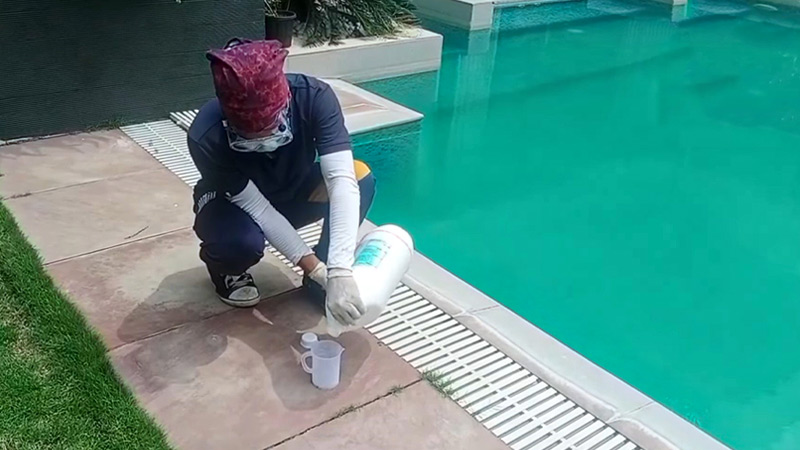
So, you must consider what chlorine level is too high to swim. Indeed, it is essential to have a clear idea of What is the highest chlorine level safe to swim in for safe swimming.
Chlorine levels above 3 ppm can lead to skin and eye irritation, while concentrations above 5 ppm may cause respiratory discomfort.
Skin and Eye Irritation
When the chlorine level in a swimming pool exceeds 3 parts per million (ppm), it can lead to skin and eye irritation among swimmers. Higher chlorine concentrations can cause redness, itching, and discomfort, making the swimming experience unpleasant.
Respiratory Discomfort
Chlorine levels that are too high, typically above 5 ppm, can also result in respiratory issues. Swimmers may experience coughing, throat irritation, and difficulty breathing when exposed to excessive chlorine fumes.
Chemical Burns
Chlorine levels exceeding 10 ppm chlorine in the pool can be dangerous, potentially causing chemical burns on the skin, eyes, and mucous membranes. These burns can be severe and require immediate medical attention. Swimmers should avoid pools with chlorine levels this high.
Chlorine levels exceeding 10 ppm chlorine safe to swim in are dangerous and can result in chemical burns. It’s essential to regularly test and maintain chlorine levels within the recommended range of 1 to 3 ppm for a safe and enjoyable swimming experience.
Signs of High Chlorine Levels
Signs of high chlorine levels in a swimming pool include:
Strong Chlorine Odor
A noticeable and pungent chlorine smell in the pool area can indicate elevated chlorine levels. This odor is often associated with chlorine reacting with contaminants in the water.
Skin and Eye Irritation
Swimmers may experience skin redness, itching, and eye irritation when chlorine levels are too high. These discomforts can be immediate and are a clear sign of over-chlorination.
Cloudy or Murky Water
Contrary to the expectation of crystal-clear water, high chlorine levels can sometimes lead to cloudy or murky pool water due to chemical imbalances caused by excessive chlorine.
Bleached Swimwear
Excessive chlorine can cause swimwear and pool equipment to fade or bleach over time. If you notice colors fading quickly, it could be due to high chlorine levels.
Difficulty Breathing
In extreme cases, swimmers may experience difficulty breathing, coughing, or throat irritation when exposed to high chlorine levels, especially in poorly ventilated indoor pools.
Testing Confirms High Levels
The most accurate way to determine high chlorine levels is by using pool water testing kits or strips. Testing will provide a precise measurement of the chlorine concentration in the pool.
If you observe these signs or suspect high chlorine levels, it’s essential to take corrective action promptly to ensure the safety and comfort of swimmers.
This may involve diluting the pool water, adjusting the chlorine feeder, or consulting a pool professional for guidance.
Health Risks Associated with High Chlorine Levels
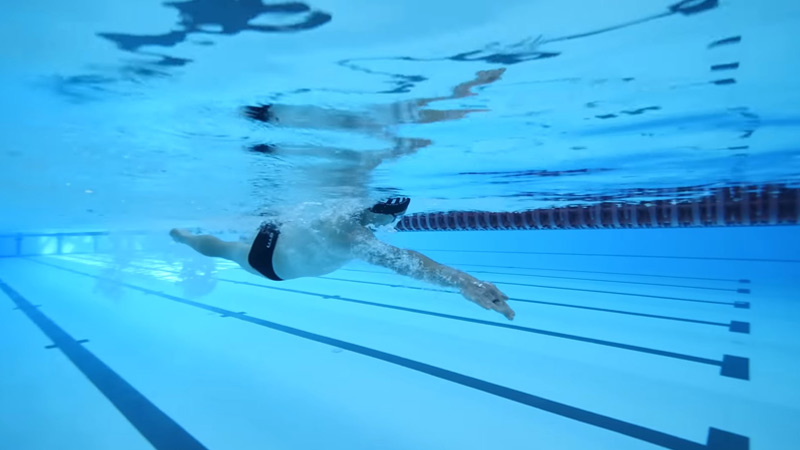
High chlorine levels in swimming pools can pose several health risks, including:
Skin and Eye Irritation
Excessive chlorine exposure can lead to skin redness, itching, and eye irritation. Swimmers may experience discomfort, and those with sensitive skin or allergies can be particularly affected.
Respiratory Problems
Breathing in chlorine fumes, especially in poorly ventilated indoor pools with high chlorine levels, can cause respiratory issues. Swimmers may develop coughing, wheezing, and throat irritation.
Chemical Burns
In extreme cases, when chlorine levels are significantly above recommended levels (e.g., above 10 ppm), it can result in chemical burns on the skin, eyes, and mucous membranes.
These burns can be painful and require immediate medical attention.
Aggravation of Preexisting Conditions
High chlorine levels can exacerbate preexisting health conditions, such as asthma or allergies, making it difficult for individuals with these conditions to swim comfortably.
Gastrointestinal Distress
Swallowing pool water with elevated chlorine levels can lead to gastrointestinal discomfort, including nausea, vomiting, and diarrhea.
Weakened Immune Response
Chronic exposure to high chlorine levels can potentially weaken the immune system, making individuals more susceptible to infections and illnesses.
Long-term Effects
Prolonged exposure to excessive chlorine may contribute to the development of chronic skin conditions and respiratory problems in some individuals.
To mitigate these health risks, it’s crucial to regularly test and maintain chlorine levels within the recommended range (typically 1 to 3 ppm) and follow proper pool maintenance and water chemistry practices.
If you suspect high chlorine levels or experience any of these health issues while swimming, it’s advisable to exit the pool and seek fresh air or medical attention if necessary.
Causes of High Chlorine Levels
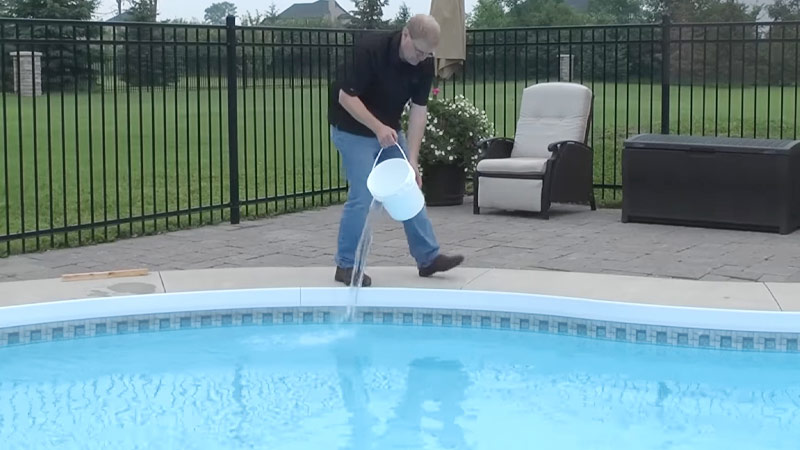
High chlorine levels in swimming pools can result from various factors and issues, including:
Over-chlorination
Adding too much chlorine to the pool intentionally during routine maintenance can lead to high levels. This can occur due to miscalculations or errors in chemical dosing.
Faulty Chlorine Feeder
Malfunctioning automatic chlorine feeders or chemical dispensing systems can release excess chlorine into the pool water, especially when they are stuck in the “on” position.
Inadequate Dilution
Filling a pool with fresh water without proper dilution of existing chlorinated water can result in high chlorine levels. This commonly happens when topping off a pool without thorough mixing.
Erratic pH Levels
Imbalanced pH levels can affect the effectiveness of chlorine. When pH is too high (alkaline), chlorine becomes less effective, leading to the addition of more chlorine than needed to achieve the desired disinfection.
Sunlight Exposure
Pools that are exposed to intense sunlight can experience higher chlorine demand, requiring more chlorine to maintain safe levels. If the chlorine isn’t adjusted accordingly, it can accumulate.
Algae Blooms
Severe algae infestations may necessitate a shock treatment with a high dose of chlorine. If not managed carefully, this can temporarily raise chlorine levels until they normalize.
Low Bather Load
High chlorine levels can occur in pools with low or sporadic use because there are fewer swimmers to consume the chlorine. This reduced demand can lead to the accumulation of chlorine.
Chemical Imbalances
Imbalanced water chemistry, including high levels of cyanuric acid (stabilizer) or calcium hardness, can affect chlorine effectiveness, leading to the need for higher chlorine levels.
To prevent high chlorine levels, pool owners should regularly test and adjust water chemistry, use automatic chemical feeders correctly, and ensure proper pool maintenance.
Monitoring chlorine levels and pH regularly can help maintain a safe and enjoyable swimming environment.
Strategies for Correcting High Chlorine Levels
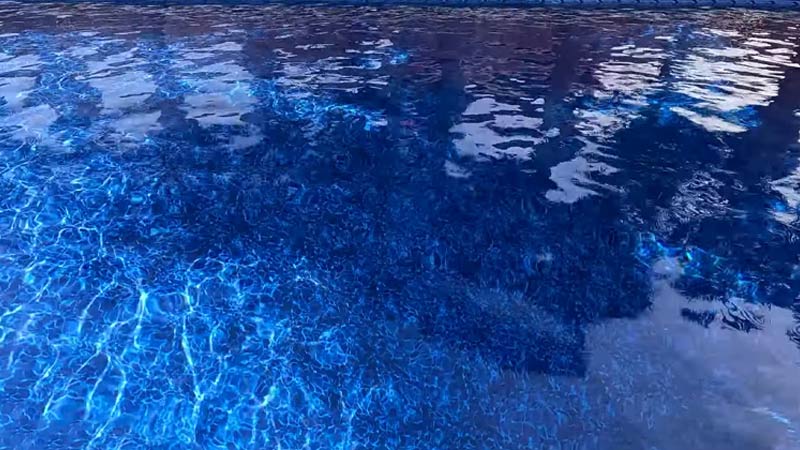
If you discover that your swimming pool has high chlorine levels, there are several strategies to correct the situation and restore safe and comfortable swimming conditions:
Stop Chlorine Addition
Immediately halt any chlorine additions to the pool. This includes turning off automatic chlorine feeders, halting the use of chlorine tablets, and discontinuing the addition of liquid or granular chlorine products.
Dilution with Fresh Water
The most effective way to reduce chlorine levels is by diluting the pool water with fresh water. You can achieve this by draining a portion of the pool and replacing it with water that has no or low chlorine content.
Gradually testing and adjusting chlorine levels until they fall within the recommended range (1 to 3 ppm).
Aeration
Increase aeration in the pool to help dissipate excess chlorine more rapidly. This can be done by running pool jets, fountains, or waterfalls. Increased circulation and exposure to air will promote chlorine off-gassing.
Use a Dechlorinator
Adding a dechlorination product specifically designed for pools can help reduce chlorine levels. Follow the manufacturer’s instructions for the appropriate dosage.
Test and Monitor
Continuously monitor chlorine levels using a reliable pool water testing kit or test strips. Make adjustments as necessary to gradually bring chlorine levels back into the safe range.
pH Adjustment
Check and adjust the pool’s pH level if it is not within the recommended range (7.4 to 7.6). Balanced pH levels can help chlorine work more effectively.
Consult a Professional
If you’re unsure about how to correct high chlorine levels or if the situation persists, consider seeking advice from a pool professional or technician who can provide guidance and perform necessary adjustments.
Prevent Future Occurrences
To prevent high chlorine levels in the future, always follow proper dosing guidelines, maintain good water chemistry, and regularly test and adjust chemical levels to ensure they remain within the recommended ranges.
Remember that safety is paramount when handling pool chemicals. Always follow manufacturer instructions, wear appropriate protective gear, and keep pool chemicals out of reach of children and pets.
FAQs
Is 5 ppm chlorine safe to swim?
Yes, 5 ppm (parts per million) of chlorine is generally safe for swimming. This level helps disinfect pool water and maintain water quality without posing a significant health risk to swimmers.
What Is the max chlorine level for swimming?
The recommended maximum chlorine level for swimming pools is typically 4-5 ppm. Going above this level can lead to skin and eye irritation, making it important to maintain chlorine within this range.
Is 10 ppm chlorine dangerous?
Yes, 10 ppm of chlorine in a swimming pool is considered dangerous.
It can cause skin and eye irritation, respiratory problems, and other health issues for swimmers. Reducing chlorine levels to the recommended range is essential for safety.
Is 20 ppm chlorine dangerous?
Yes, 20 ppm of chlorine in a swimming pool is highly dangerous. Exposure to such high levels can lead to severe health problems, including chemical burns, respiratory distress, and eye damage.
Immediate corrective action and dilution of chlorine are crucial in this case.
Wrapping Up
In the quest for a pristine pool, understanding when your chlorine levels are too high is paramount. Over-chlorination not only threatens swimmers’ well-being but can also degrade pool equipment and surfaces over time.
By staying within recommended chlorine ranges, regularly testing water quality, and knowing how to correct excessive chlorine, you can enjoy a clean, refreshing swim without the worry of chemical-related health concerns.
Your pool should be a source of fun and relaxation, and with the right knowledge, you can ensure it remains a safe haven for you, your family, and your guests.
So, how high can chlorine be to swim is very essential to measure. Remember to keep chlorine levels in check, and dive into a worry-free swimming experience.

